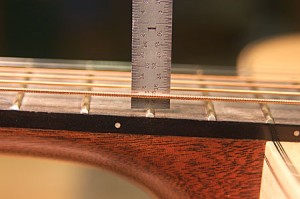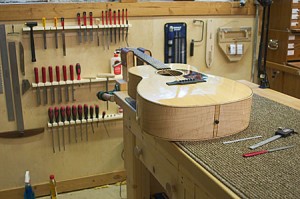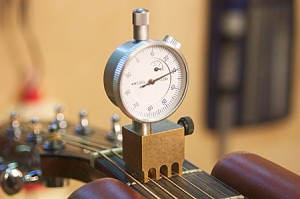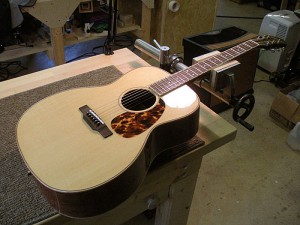 I’ve played guitar since I was in high school, which was longer ago than I care to dwell on! I am also the sort of person who lives by the axiom, “If it ain’t broke don’t fix it!”
I’ve played guitar since I was in high school, which was longer ago than I care to dwell on! I am also the sort of person who lives by the axiom, “If it ain’t broke don’t fix it!”
Because of this, I did not understand the benefits of having my guitars setup and serviced by a luthier for most of my early years as a player. I also tended to believe that something must be flawed with my guitar if it needed anything other than new strings occasionally. As long as I could play it and nothing seemed wrong, I figured that all was well.
 The fact is, most guitars can really benefit from a good professional setup. Even well-made guitars are subject to the stresses of changing weather conditions, string tension, and the relative fragility of the thin woods that are needed in order to resonate with rich tone. When you combine these factors with the reality that many factory-made guitars come with a less-than-ideal setup to begin with, the need for a good luthier to fine tune your instrument’s playing action becomes apparent. Commercially made guitars are generally shipped out with too much neck relief (to prevent customer complaints about buzzing), too high an action (for the same reason), and with excessively high nut slots. Quality acoustics will usually come with nicely polished level frets, but most new guitars (especially electrics with bolt-on necks) need to have the frets leveled and dressed. And even the finest custom instruments will benefit from an occasional tune-up, just like a high end sports car.
The fact is, most guitars can really benefit from a good professional setup. Even well-made guitars are subject to the stresses of changing weather conditions, string tension, and the relative fragility of the thin woods that are needed in order to resonate with rich tone. When you combine these factors with the reality that many factory-made guitars come with a less-than-ideal setup to begin with, the need for a good luthier to fine tune your instrument’s playing action becomes apparent. Commercially made guitars are generally shipped out with too much neck relief (to prevent customer complaints about buzzing), too high an action (for the same reason), and with excessively high nut slots. Quality acoustics will usually come with nicely polished level frets, but most new guitars (especially electrics with bolt-on necks) need to have the frets leveled and dressed. And even the finest custom instruments will benefit from an occasional tune-up, just like a high end sports car.
 A basic setup will include checking and setting the amount of bow in the neck, called relief, by adjusting the truss rod. If all else is as it should be (level fretboard and frets, etc.) there does not need to be much relief in the neck, and a properly setup guitar will not buzz with a nearly flat neck. The action (string height above the frets) will be checked and adjusted at the first and twelfth frets. This is accomplished by adjusting the nut slots and saddle height. The truss rod is for keeping the neck straight against the pull of the strings, not for adjusting action. As long as the frets are in good shape, setting neck relief and string action are the elements of a basic setup, along with the installation of a set of new strings. A check of the battery (if the guitar has one) and tightening of the tuner nuts and screws rounds out the basic service.
A basic setup will include checking and setting the amount of bow in the neck, called relief, by adjusting the truss rod. If all else is as it should be (level fretboard and frets, etc.) there does not need to be much relief in the neck, and a properly setup guitar will not buzz with a nearly flat neck. The action (string height above the frets) will be checked and adjusted at the first and twelfth frets. This is accomplished by adjusting the nut slots and saddle height. The truss rod is for keeping the neck straight against the pull of the strings, not for adjusting action. As long as the frets are in good shape, setting neck relief and string action are the elements of a basic setup, along with the installation of a set of new strings. A check of the battery (if the guitar has one) and tightening of the tuner nuts and screws rounds out the basic service.
 A well-setup guitar will play well all the way up and down the neck, with no buzzing frets. It won’t require excessive hand pressure to play bar chords, and it will look and play up to it’s potential. It is a low-cost way to get the most out of any guitar as it currently exists. In part two of this article, I’ll discuss some more improvements that can be made to get even more tone from your instrument.
A well-setup guitar will play well all the way up and down the neck, with no buzzing frets. It won’t require excessive hand pressure to play bar chords, and it will look and play up to it’s potential. It is a low-cost way to get the most out of any guitar as it currently exists. In part two of this article, I’ll discuss some more improvements that can be made to get even more tone from your instrument.

